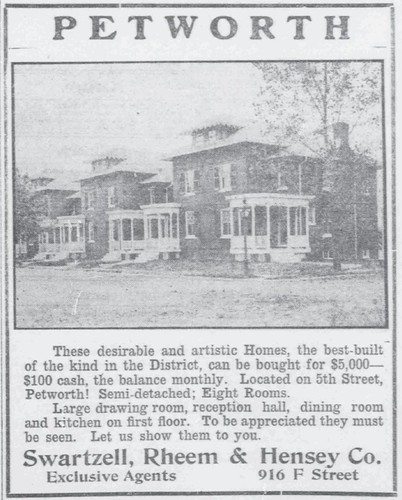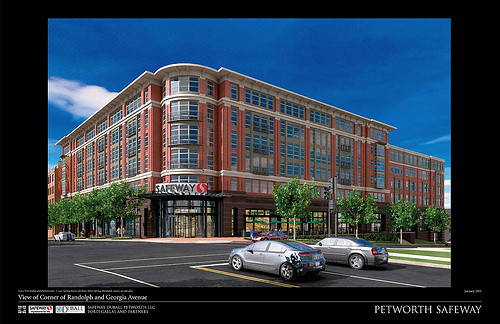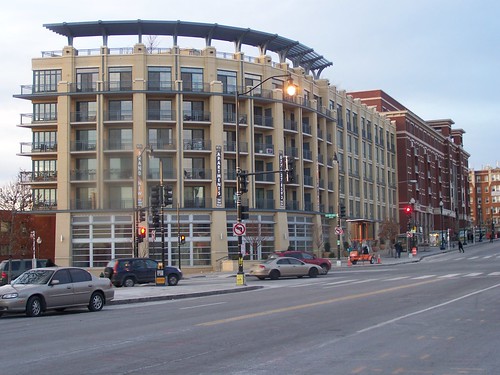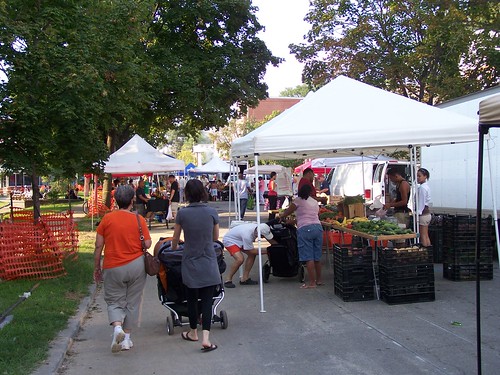American Prospect throws in its contribution to the gentrification of Washington discussion, with the piece, "
A City Divided: September 11 was good for Washington, D.C.’s economy, but the expansion has not helped many on the bottom" More venturesome than others, instead of writing about H Street or Shaw, they discuss Petworth in upper northwest DC.
The problem with these kinds of pieces is that because their frame of reference is typically flawed, they end up not contributing very much to the discourse about urban policy and revitalization.
It's not all that interesting to me to read a description of a place as much as it is to figure out how the lessons "learned" contribute to broader understandings that I can apply elsewhere.
E.g., neighborhood change over the last 10+ years in DC is particularly interesting to me because with the exception of similar kinds of changes in Brooklyn and maybe in Center City Philadelphia, for the most part, equivalent change did not occur in other center cities with roughly similar conditions, in particular a large minority population (which takes Seattle and Portland out of the equation).
Figuring out why the changes occurred becomes important if you want to improve urban policy generally and other places specifically.
Attributing the change to post-9/11 growth of the federal government as is done in the American Prospect piece, I don't think explains what is happening.
The things that I say are key to DC's competitive advantages are more important:
1. historic residential building stock (that is attractive to people with choices), and neighborhoods proximate to the central business district;
2. pedestrian-centric urban design in the core of the city;
3. historicity, identity, and authenticity;
4. a robust transit infrastructure (in the core of the city especially), which allows for efficient and effective mobility by transit and doesn't require a car;
5. the (now relatively, but slowing) steady employment engine of the federal government.
But this pre-supposes that the local center city, in this case Washington, is relatively attractive in terms of the quality of life, public safety, and the provision of municipal services. This is key because urban neighborhoods must compete with suburban neighborhoods for residents.
What changed this equation for DC was two-fold. First, and most importantly, Marion Barry was no longer mayor of the city, with the election of Anthony Williams in 1998. As the city government refocused attention on delivering services and addressing crime, this changed the investment climate specifically for both commercial and multiunit residential development.
(To be fair other things happened during the Barry years which contributed to this improvement, such as the relocation of the professional basketball and hockey teams to Downtown DC from the Maryland suburbs, which helped to intensify redevelopment in what used to be called the city's "east end," which is now full of apartment and condominium buildings and a strong retail and entertainment center at Gallery Place, which took 20 years to develop after the opening of the subway system.)
Second, was the achievement of critical mass in terms of the willingness of "younger people" with choices choosing to live in the center city. Before, younger households still chose the suburbs over the center city. But with tv shows like "Friends" and "Seinfeld" (versus say "The Brady Bunch") perception of the center city as a choice place to live changed.
This is important because for the past 20 years (not 10 years as stated in the American Prospect article), DC's black population has been dropping--in large part as the black middle classes decamped to the suburbs, abandoning the city, just as the whites had done in the 1950s.
If not for an influx of white and Hispanic residents, DC's population would have steadily declined over the past 20 years because of black outmigration. See "
The New Black Suburbs" from the
New York Times Sunday Magazine, 6/14/1992, ironically featuring Jack and Leslie Johnson on the cover.
Getting back to Petworth
What is driving the change in Petworth specifically is the presence of attractive rowhouses AND the Green Line subway station AND the building of infill multinunit housing on Georgia Avenue proximate to the subway station. Plus the influx of new population is reshaping the retail environment, an independent coffee shop, one of DC's few hip neighborhood restaurants not owned by a chainlet, Domku, a branch of the Yes Organic Market.
In response to the changes, Safeway announced they will redevelop their tired store into a mixed use housing development with a spanking new store on the ground floor ... although I worry that this plan might not go through because of the development of a Walmart store up the street, not quite 2 miles away.
Current and proposed Safeway store, Petworth
The part of the Green Line serving Petworth and Columbia Heights didn't open until 1999. So it makes sense that these neighborhoods didn't begin repositioning until afterwards (not unlike how north of H Street NE became more attractive upon the opening of the New York Avenue Metro station in late 2004 and the subsequent intensification of the "NoMA" district west of the railroad tracks).
City and WMATA planning and development initiatives encouraged the creation of multiunit residential buildings at these subway stations. As closer in locations were developed in the core of the city, Columbia Heights and Petworth have become more attractive to people looking for starter housing and proximity to Downtown. What is key is that the land around these stations has been developed to support urbanism, unlike development at Fort Totten and Rhode Island station, which is why those areas have lagged compared to other improving areas in other parts of the city (note that I don't include Fort Totten in my list of 31 stations "at the core of the city.")
I wrote about this general issue in an op-ed in the
Philadelphia Daily News in 2003, "
An outsider's version for saving Philly," but I don't think that I truly appreciated the difficulty of changing people's perceptions about being willing to live in a declining center city.
DC, because of the historic preservation movement over the past decades, has many stable neighborhoods that have maintained their ability to attract high-income residents even in worse times.
Plus, at the core of the city, DC has about 31 transit stations (I used to say 29 stations, but in an entry not quite two years ago, a commenter argued that this list should be expanded to include the Waterfront and Navy Yard stations on the Green Line, because of redevelopment activities in those areas, and I have to agree) over a 15 square mile area. For the most part, all of these neighborhoods served by those stations are improving (with the exception of the area around Rhode Island Station).
These are key differences then, between DC and other center cities and weren't adequately captured in the American Prospect article.
In any case, it still sucks to be poorer when the market economy decides that your neighborhood is worth reconnecting to the broader residential and commercial landscape within your city and region.
This photo: Park Place Apartments, Georgia and New Hampshire Avenues, Park View-Petworth. Next photo: Petworth Farmers Market.
Labels: contested spaces, gentrification, invasion-succession theory, neighborhood change, urban revitalization








1 Comments:
I liked the test and the site very much. thanks.
Post a Comment
<< Home